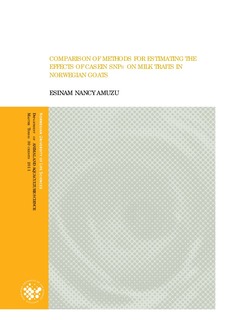| dc.description.abstract | The four casein proteins make up the majority of protein in goat’s milk. They are encoded by 4 closely linked genes, CSN1S1, CSN2, CSN1S2 and CSN3 within a 250 kb segment on chromosome 6. Polymorphisms of these genes are of interest to animal breeders due to their effect on milk composition and quality. Due to the linkage between them, methods for analysis of this genomic region have mostly been at the haplotype level. A multi-SNP approach was used in this study. We assessed the suitability of two multivariate statistical methods, partial least squares and principal component regression, for the detection of the additive effects of casein polymorphisms on milk traits. These methods are well suited for analysis of collinear variables. Genotype information on 38 casein SNPs, and phenotypic records on milk yield, somatic cell count, fat, protein, and lactose percentages were obtained for 565 goats from 6 Norwegian farms. Three models were compared. After correcting the records for fixed and permanent environment effects, PLSR was run on single traits at a time (model 1) and then jointly for all traits but milk yield (model 2). For the third model the scores from PCA were collected and used as fixed effects in an animal model. The PLS-based methods clearly detected significant effects of SNPs in the CSN1S1 and CSN3 regions, consistent with previous findings. Three SNPs in the CSN2 gene had positive effects on fat and protein percent and negative effects on somatic cell count. A Norwegian-specific deletion in exon 12 of CSN1S1 had a significant negative effect on fat and protein percent (p<0.05). Estimates from Model 3 generally had higher SEs, and only identified significant effects on fat and milk yield. It was however able to detect the effect of the exon 12 deletion on fat percent. Overall, the PLS based models identified a higher number of effects as significant, fat and protein percent were better explained by the models than the other traits, and SNPs at CSN1S1 and CSN3 appear to be the most important for detecting variability in milk traits. | en_US |
